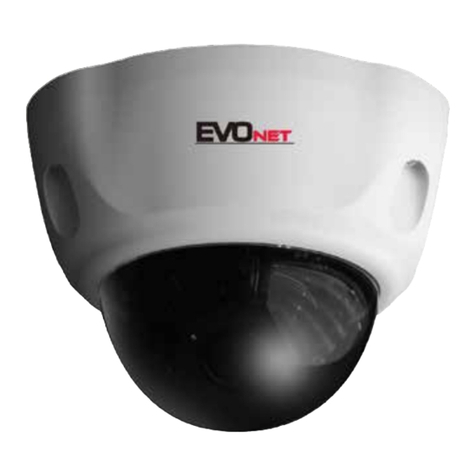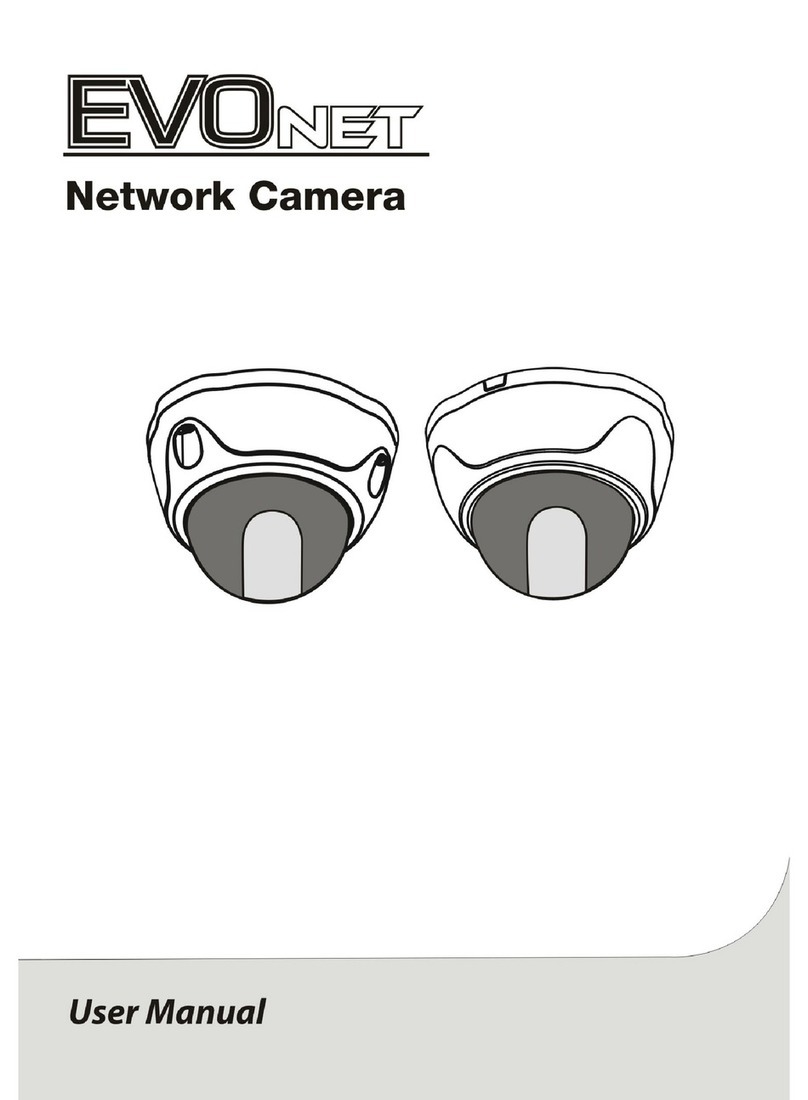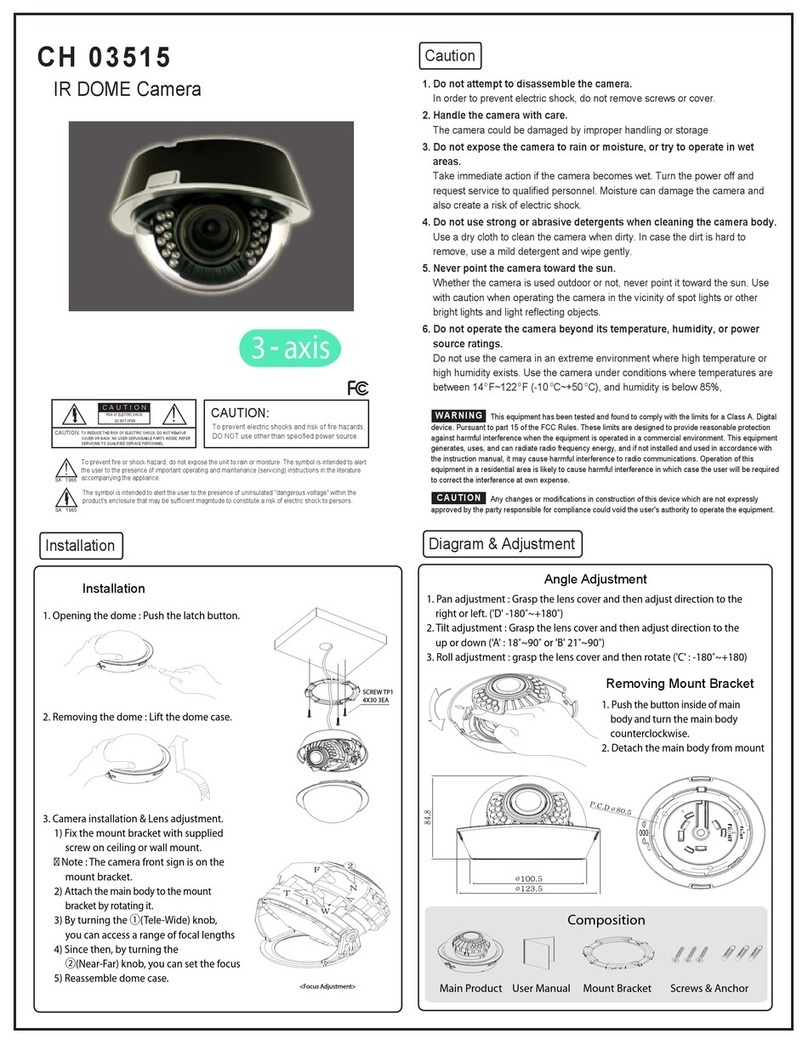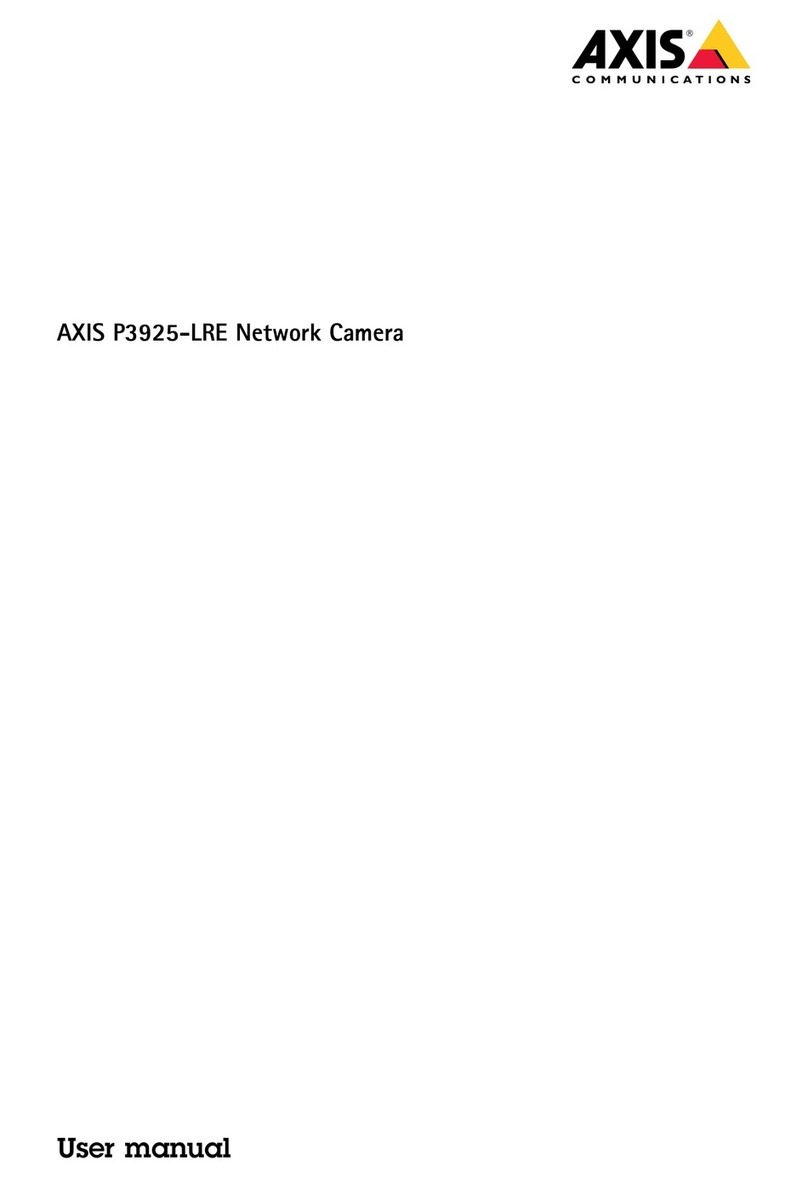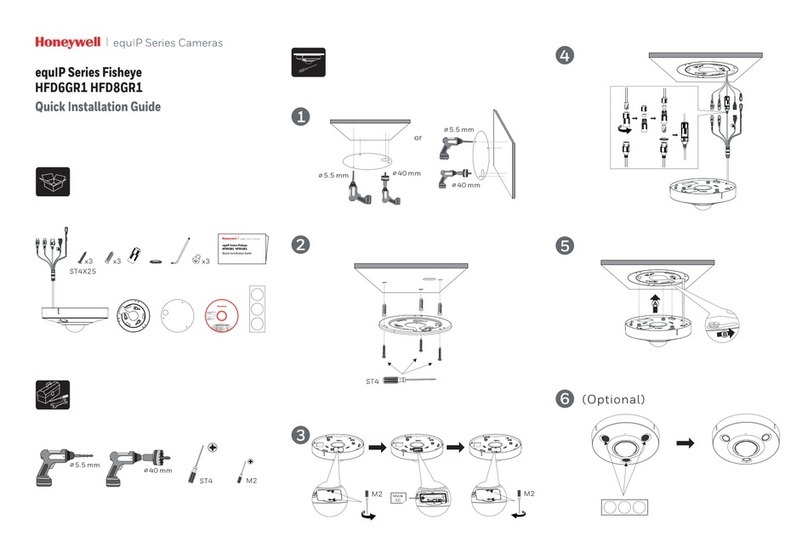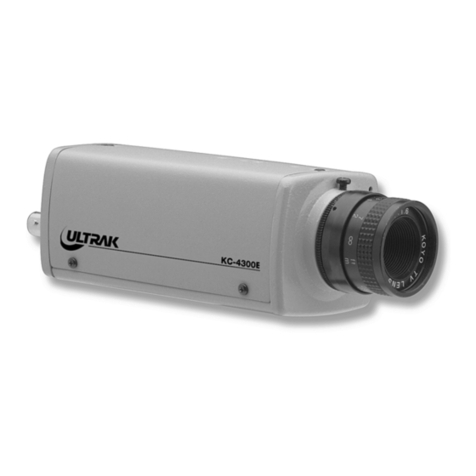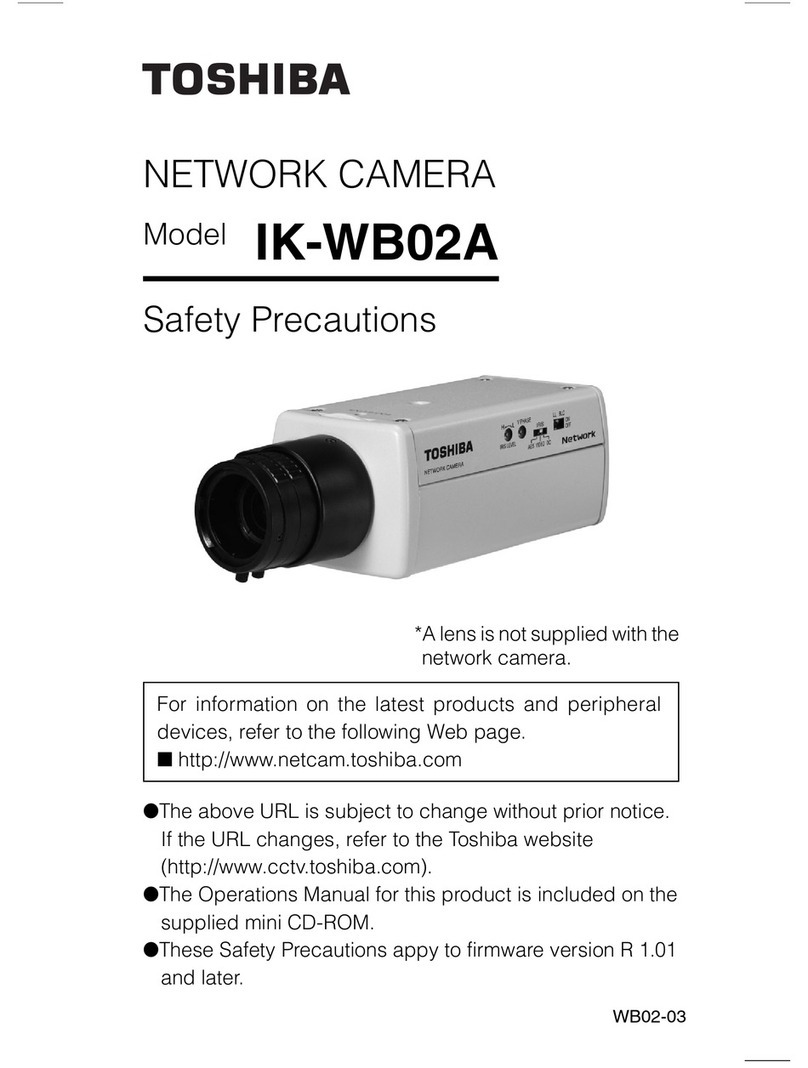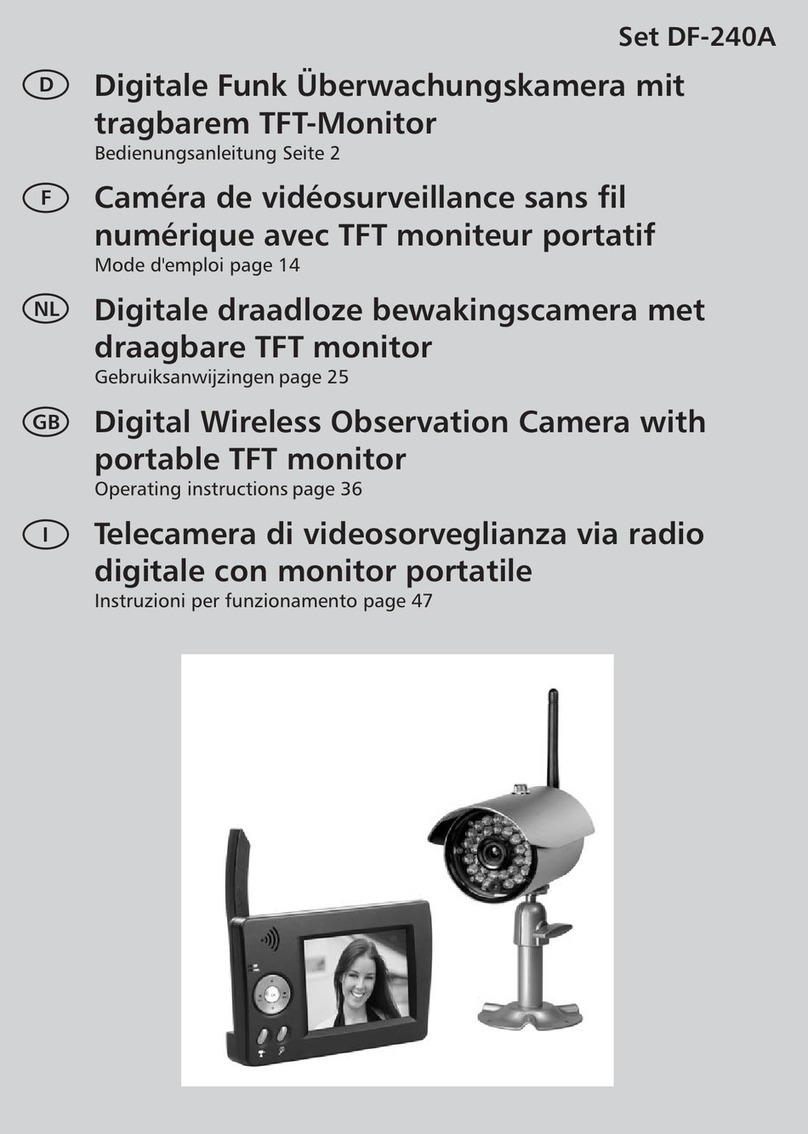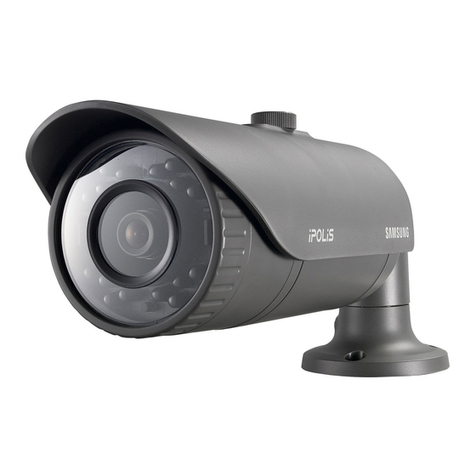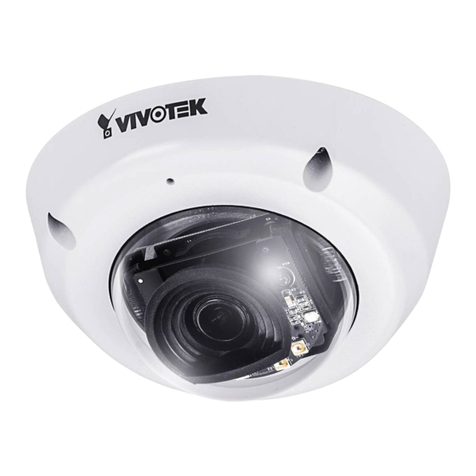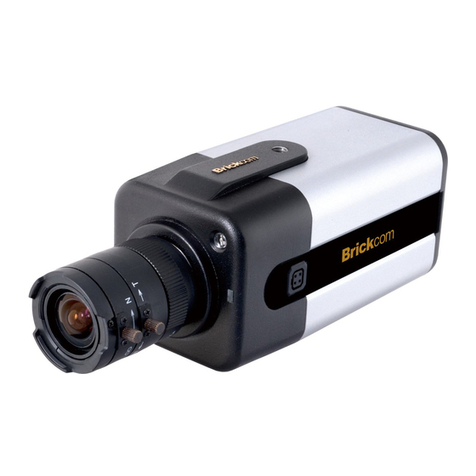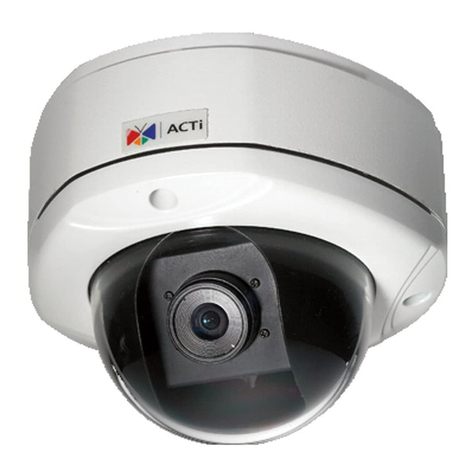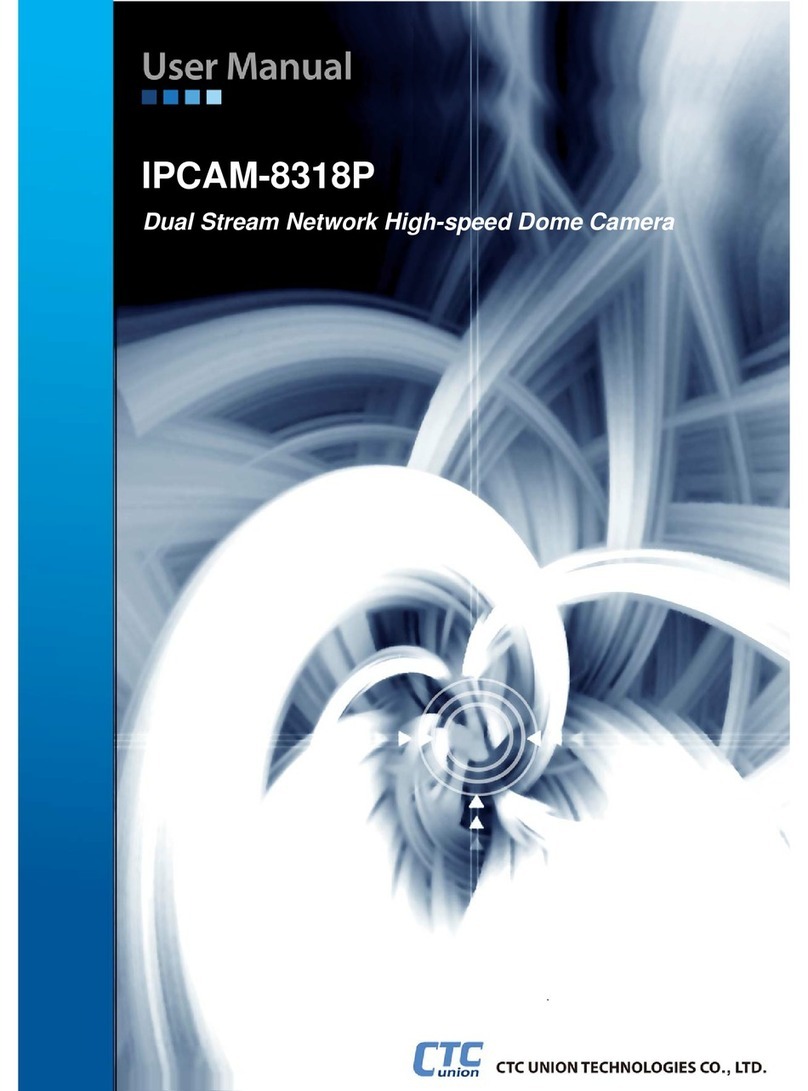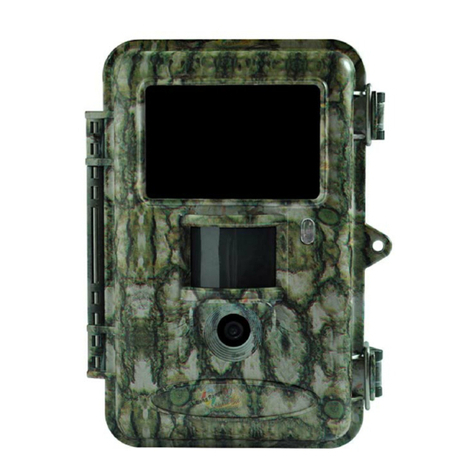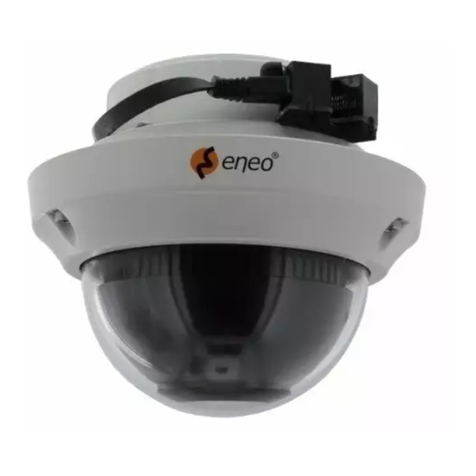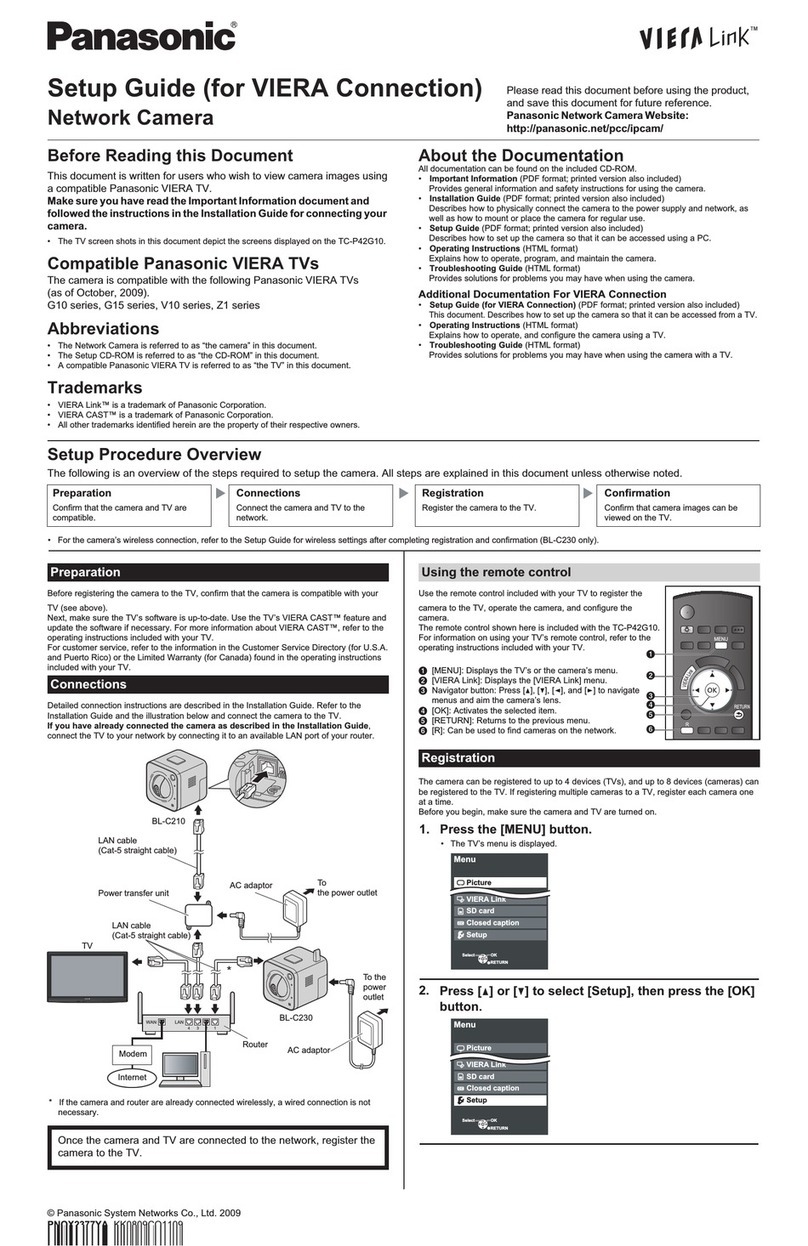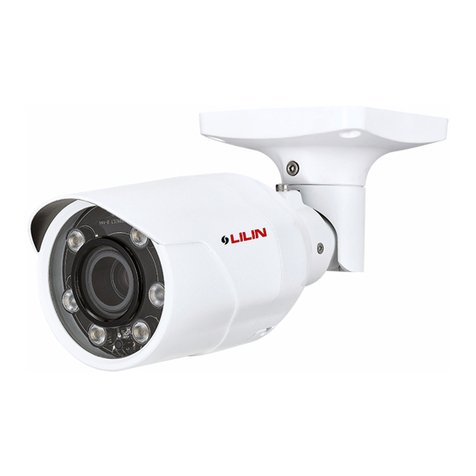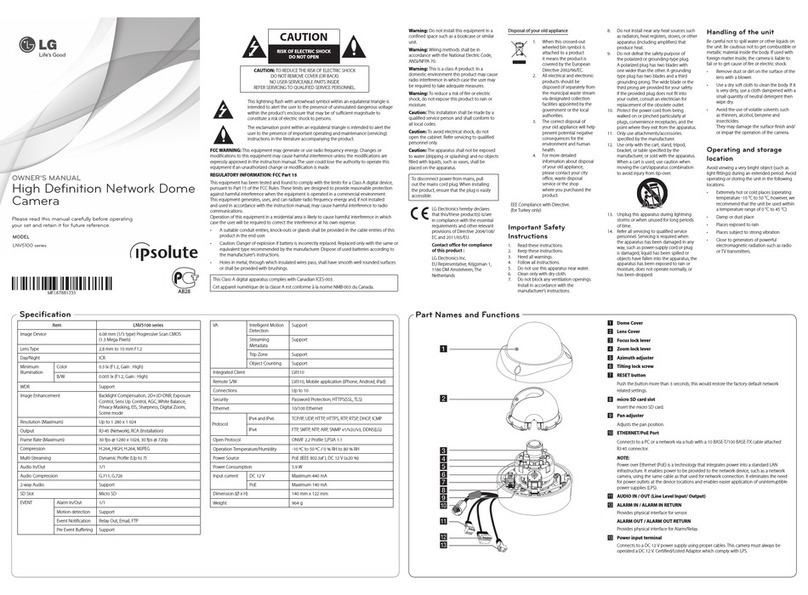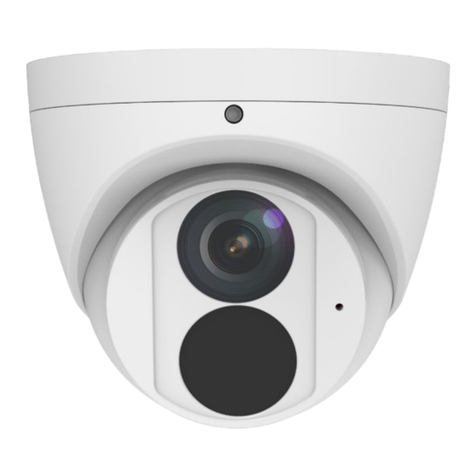EVOnet network camera User manual



Network Camera
i
WARNING
RISK OF ELECTRIC SHOCK
DO NOT OPEN
WARNING: TO REDUCE THE RISK OF ELECTRIC SHOCK,
DO NOT REMOVE COVER (OR BACK).
NO USER-SERVICEABLE PARTS INSIDE.
REFER SERVICING TO QUALIFIED
SERVICE PERSONNEL.
COMPLIANCE NOTICE OF FCC:
THIS EQUIPMENT HAS BEEN TESTED AND FOUND TO COMPLY WITH THE LIMITS FOR A CLASS
A DIGITAL DEVICE, PURSUANT TO PART 15 OF THE FCC RULES. THESE LIMITS ARE DESIGNED
TO PROVIDE REASONABLE PROTECTION AGAINST HARMFUL INTERFERENCE WHEN THE
EQUIPMENT IS OPERATED IN A COMMERCIAL ENVIRONMENT. THIS EQUIPMENT GENERATES,
USES, AND CAN RADIATE RADIO FREQUENCY ENERGY AND IF NOT INSTALLED AND USED IN
ACCORDANCE WITH THE INSTRUCTION MANUAL, MAY CAUSE HARMFUL INTERFERENCE TO
RADIO COMMUNICATIONS. OPERATION OF THIS EQUIPMENT IN A RESIDENTIAL AREA IS
LIKELY TO CAUSE HARMFUL INTERFERENCE, IN WHICH CASE USERS WILL BE REQUIRED TO
CORRECT THE INTERFERENCE AT THEIR OWN EXPENSE.
WARNING: CHANGES OR MODIFICATIONS NOT EXPRESSLY APPROVED BY THE PARTY
RESPONSIBLE FOR COMPLIANCE COULD VOID THE USER’S AUTHORITY TO OPERATE THE
EQUIPMENT.
THIS CLASS OF DIGITAL APPARATUS MEETS ALL REQUIREMENTS OF THE CANADIAN
INTERFERENCE-CAUSING EQUIPMENT REGULATIONS.
The information in this manual is believed to be accurate as of the date of publication. We are not responsible for any
problems resulting from the use thereof. The information contained herein is subject to change without notice.
Revisions or new editions to this publication may be issued to incorporate such changes.
The software included in this product contains some Open Sources. You may obtain the complete
corresponding source code from us. See the Open Source Guide on the software CD (OpenSourceGuide\
OpenSourceGuide.pdf) or as a printed document included along with the User's Manual.
WEEE (Waste Electrical & Electronic Equipment)
Correct Disposal of This Product
(Applicable in the European Union and other European countries with separate collection systems)
This marking shown on the product or its literature, indicates that it should not be disposed with other household
wastes at the end of its working life. To prevent possible harm to the environment or human health from uncontrolled
waste disposal, please separate this from other types of wastes and recycle it responsibly to promote the sustainable
reuse of material resources.
Household users should contact either the retailer where they purchased this product, or their local government
office, for details of where and how they can take this item for environmentally safe recycling.
Business users should contact their supplier and check the terms and conditions of the purchase contract. This
product should not be mixed with other commercial wastes for disposal.

User’s Manual
ii
Important Safeguards
1. Read Instructions
All the safety and operating instructions should be read
before the appliance is operated.
2. Retain Instructions
The safety and operating instructions should be retained for
future reference.
3. Cleaning
Unplug this equipment from the wall outlet before cleaning
it. Do not use liquid aerosol cleaners. Use a damp soft cloth
for cleaning.
4. Attachments
Never add any attachments and/or equipment without the
approval of the manufacturer as such additions may result in
the risk of fire, electric shock or other personal injury.
5. Water and/or Moisture
Do not use this equipment near water or in contact with water.
6. Placing and Accessories
Do not place this equipment on an wall or ceiling that is not
strong enough to sustain the camera. The equipment may
fall, causing serious injury to a child or adult, and serious
damage to the equipment. Wall or shelf mounting should
follow the manufacturer's instructions, and should use a
mounting kit approved by the manufacturer.
This equipment and cart combination should be moved with
care. Quick stops, excessive force, and uneven surfaces
may cause the equipment and cart combination to overturn.
Do not place this equipment in an enclosed space. Sufficient
ventilation is required to prevent an increase in ambient
temperature which can cause malfunction or the risk of fire.
7. Power Sources
This equipment should be operated only from the type of
power source indicated on the marking label. If you are not
sure of the type of power, please consult your equipment
dealer or local power company.
8. Power Cord
Operator or installer must remove power and TNT connections
before handling the equipment.
9. Lightning
For added protection for this equipment during a lightning
storm, or when it is left unattended and unused for long
periods of time, unplug it from the wall outlet and disconnect
the antenna or cable system. This will prevent damage to
the equipment due to lightning and power-line surges. If
thunder or lightning is common where the equipment is
installed, use a surge protection device.
10. Overloading
Do not overload wall outlets and extension cords as this can
result in the risk of fire or electric shock.
11. Objects and Liquids
Never push objects of any kind through openings of this
equipment as they may touch dangerous voltage points or
short out parts that could result in a fire or electric shock.
Never spill liquid of any kind on the equipment.
12. Servicing
Do not attempt to service this equipment yourself. Refer all
servicing to qualified service personnel.
13. Damage requiring Service
Unplug this equipment from the wall outlet and refer
servicing to qualified service personnel under the following
conditions:
A. When the power-supply cord or the plug has been
damaged.
B. If liquid is spilled, or objects have hit the equipment.
C. If the equipment has been exposed to rain or water.
D. If the equipment does not operate normally by following
the operating instructions, adjust only those controls that
are covered by the operating instructions as an improper
adjustment of other controls may result in damage and
will often require extensive work by a qualified technician
to restore the equipment to its normal operation.
E. If the equipment has been dropped, or the cabinet damaged.
F. When the equipment exhibits a distinct change in
performance — this indicates a need for service.
14. Replacement Parts
When replacement parts are required, be sure the service
technician has used replacement parts specified by the
manufacturer or that have the same characteristics as the
original part. Unauthorized substitutions may result in fire,
electric shock or other hazards.
15. Safety Check
Upon completion of any service or repairs to this equipment,
ask the service technician to perform safety checks to determine
that the equipment is in proper operating condition.
16. Field Installation
This installation should be made by a qualified service person
and should conform to all local codes.
17. Correct Batteries
Warning: Risk of explosion if battery is replaced by an incorrect
type. Dispose of used batteries according to the instructions.
18. Tmra
A manufacturer’s maximum recommended ambient temperature
(Tmra) for the equipment must be specified so that the customer
and installer may determine a suitable maximum operating
environment for the equipment.

Network Camera
iii
Table of Contents
Chapter 1 — Introduction ............................................................................. 1
In This Manual.......................................................................................... 1
Features ................................................................................................... 1
Typical Applications ................................................................................. 2
Chapter 2 — Installation............................................................................... 5
Package Contents.................................................................................... 5
Dimensions .............................................................................................. 5
Front Side View........................................................................................ 6
Right Side View........................................................................................ 6
Top View .................................................................................................. 6
Factory Reset..................................................................................... 7
Rear View................................................................................................. 7
Installation ................................................................................................ 8
Manual Iris Lens................................................................................. 9
DC-Type Auto Iris Lens...................................................................... 9
CS-Mount Lens ................................................................................ 10
C-Mount Lens................................................................................... 10
Chapter 3 — Remote Setup....................................................................... 11
Quick Setup............................................................................................ 12
System ................................................................................................... 12
General ............................................................................................ 12
Date/Time......................................................................................... 13
User/Group....................................................................................... 14
Network .................................................................................................. 15
IP Address........................................................................................ 15
DVRNS............................................................................................. 16
Port/QoS .......................................................................................... 17
Bandwidth Control............................................................................ 19
Security ............................................................................................ 20
IEEE 802.1X..................................................................................... 21
Video ...................................................................................................... 22
Camera ............................................................................................ 22
Streaming......................................................................................... 25
Webcasting ...................................................................................... 27
MAT.................................................................................................. 28
Privacy Masking ............................................................................... 29
Event Action ........................................................................................... 30
Email ................................................................................................ 30
Remote Callback.............................................................................. 31

User’s Manual
iv
FTP Upload ...................................................................................... 32
Event ...................................................................................................... 33
Motion Detection .............................................................................. 34
Trip-Zone.......................................................................................... 35
Tampering ........................................................................................ 36
System Event ................................................................................... 37
Chapter 4 — WebGuard ............................................................................ 39
Appendix .................................................................................................... 43
LED Indicators........................................................................................ 43
Connector Pin Outs................................................................................ 43
Map of Screens (Remote Setup)............................................................ 44
Troubleshooting ..................................................................................... 45
Specifications ......................................................................................... 46
Index .......................................................................................................... 49

Network Camera
1
Chapter 1 — Introduction
In This Manual
This manual is intended for users of the network camera and includes instructions for using and
managing the camera on the network.
Features
This network camera compresses live video and transmits the video over Ethernet connections.
The camera can be accessed, configured and managed by using the INIT (Integrated Network
Installation Tool) program. It has a built-in web server, WebGuard, allowing you to monitor live
video remotely using a web browser. The remote programs provided with the camera also allow
remote management, monitoring, searching and recording. This camera offers the following features:
Multistream for live monitoring and recording
H.264 and M-JPEG compression algorithm
Four levels of video compression and various video compression resolutions
Pre- and post-event buffering and video stream buffering to enhance reliability of network recording
Remote monitoring via web browser or remote software
Automatic HTML code generation for webcasting on a user’s website
Up to 10 simultaneous connections to the camera for remote monitoring
Enhanced security using IP address filtering, HTTPS, SSL and IEEE 802.1X functions and
password protected multiple user levels
Network bandwidth limit and MAT functions to use network bandwidth efficiently
Convenient network connection using the UPnP (Universal Plug and Play) function and built-in
mDNS (Multicast DNS) protocol
Support of the ONVIF protocol (Core specification version 1.02)
Digital WDR (Wide Dynamic Range) to adjust the image display in high contrast conditions
Slow shutter to reduce the minimum illumination requirements
Convenient firmware upgrades via the network connection
Firmware duplication and autorecovery functions to enhance system stability
Management of multiple cameras via Ethernet connections
Event detection functions: motion, trip-zone, tampering
Power sources: 12 VDC (all models), PoE (Power over Ethernet) (some models only)
C/CS mount lens connection
NTSC or PAL programmable video output
NOTES:
In this manual, a “remote system” refers to a PC that the remote program (SiRiS Lite or
WebGuard) is running.
Remote monitoring and recording through multistream are available by using the SiRiS Lite
program provided with the camera.

User’s Manual
2
Typical Applications
Remote Monitoring
Remote Recording

Network Camera
3
Webcasting

User’s Manual
4

Network Camera
5
Chapter 2 — Installation
Package Contents
Network Camera
C-Mount Ring
DC-Type Auto Iris Lens Connector Socket
Protective cover (attached to the unit)
Installation CD (INIT/SiRiS Lite software and User’s Manual)
Quick Reference Guide
Mount Kits
Dimensions

User’s Manual
6
Front Side View
① Image Sensor: Converts an optical image of the object
to an electric signal.
NOTE: Cover the image sensor by using the protective
cover provided with the camera when a lens is not mounted
on the camera.
Right Side View
① Protective cover
② C-Mount Ring
③ Back Focus Adjustment
Ring
④ Mount Bracket
Protective cover: Attach when a lens is not installed to protect the image sensor.
C-Mount Ring: Attach the ring provided with the camera to the camera when using the C-Mount
lens.
Back Focus Adjustment Ring: Loose screws and adjust the back focus by turning the ring
clockwise or counter-clockwise, and then tighten the screws to fix the current back focus.
Mount Bracket: You can attach a bracket to the bottom or top of the camera to mount it. Use
1/4–20 UNC (20 Thread), 2.5mm +/- 0.2 mm (ISO Standard) or 0.197 (ASA Standard) standard
screws when attaching the bracket.
Top View
① Factory Reset Switch: Use to
return all settings to the original
factory settings. See below for
details.

Network Camera
7
Factory Reset
This will only be used on the rare occasions that you want to return all the settings to the original
factory settings.
CAUTION: When performing a Factory Reset, you will lose any settings you have
saved.
Cut off the power from the camera. →Poke a straightened paperclip into the factory reset switch
hole. →Turn on the power while holding the reset switch →Release the switch in about 5 seconds
after the Power LED blinks. →The camera resets to factory defaults and restarts after completing
the factory reset.
You can perform a factory reset while the camera is turned on by pressing the factory reset switch
and releasing the reset switch. A factory reset also can be performed remotely by running the INIT
program. The camera restarts after completing the factory reset. Refer to the INIT User’s Manual
for details on remote factory resetting.
Rear View
① Auto Iris Lens Connector
② Video Out
③ Power
④ Power LED
⑤ Network Port
⑥ Network LED
Auto Iris Lens Connector: Connect the auto iris jack if the lens is a DC-type auto iris lens. Use
the lens of which the auto iris jack is long.
Video Out: Connect to a monitor. This is intended for video preview while adjusting the camera.
Power
−DC12V +/–: Connect two wires from the power adapter. You must distinguish power polarity
when connecting the wires. The camera starts booting as soon as power is applied.
−FGND (Frame GND):Ground the camera by using the grounding cable and screw.
Power LED: Indicates system operation status. See Appendix – LED Indicators for details.
The LED will not light regardless of the status if the Status LED is disabled when configuring
the System – General setup.
Network Port: Connect a Cat5 cable with an RJ-45 connector. You can change the settings,
manage the camera, upgrade the software or monitor video remotely via the network connection.
Refer to the INIT User’s Manual for details about network connection setup. When using a PoE
switch, the camera can be supplied with power over Ethernet cable (supported for not every model)
(Refer to the PoE switch manufacturer’s manual for details).

User’s Manual
8
Network LED: Indicates network connection status. See Appendix – LED Indicators for details.
The LED will not light regardless of the status if the Status LED is disabled when configuring
the System – General setup.
NOTES:
Camera surveillance may be prohibited by laws that vary by region. Check the laws in your
area before using this product for surveillance purposes.
To make connections on the power connector strip, press and hold the button and insert the
wire in the hole below the button. After releasing the button, tug gently on the wire to make
certain it is connected. To disconnect a wire, press and hold the button above the wire and
pull out the wire.
CAUTIONS:
The frame GND of the power should be grounded before using.
The camera restarts after the power adaptor is disconnected from the camera
when switching the power source from 12 VDC to PoE.
The network connector is not designed to be connected directly with cable or
wire intended for outdoor use.
It is required that you coil twice the end of the network cable in the camera side
by using the core (28A2024-0A2 model of Laird Technologies brand) provided
with the camera for EMI (electromagnetic interference) suppression.
WARNING: ROUTE POWER CORDS SO THAT THEY ARE NOT A TRIPPING HAZARD.
MAKE CERTAIN THE POWER CORD WILL NOT BE PINCHED OR ABRADED BY
FURNITURE. DO NOT INSTALL POWER CORDS UNDER RUGS OR CARPET. USE
THE POWER CORD THAT HAS A GROUNDING PIN. IF YOUR POWER OUTLET DOES
NOT HAVE A GROUNDING PIN RECEPTACLE, DO NOT MODIFY THE PLUG. DO NOT
OVERLOAD THE CIRCUIT BY PLUGGING TOO MANY DEVICES INTO ONE CIRCUIT.
Installation
A lens is not supplied with the camera. Ask your dealer or distributor about purchasing one. The
camera supports manual iris and the DC-type auto-iris lenses, and it accepts CS- and C-mount lenses.
NOTES:
A mega-pixel lens is recommended for the best image resolution.
Video-type auto-iris lenses are not supported.
Use a lens that weighs less than 1.0 lbs. (450g). If the lens weighs too much, the camera might
become unstable.
WARNING: You might need to reinforce the wall or ceiling. If the wall or ceiling is not
strong enough to support the camera, the camera might fall damaging the camera
or causing injuries.

Network Camera
9
Manual Iris Lens
1. Remove the protective cover from the camera.
2. Mount the lens on the camera by turning the lens clockwise.
3. Turn the iris ring on the lens to the open position and adjust the iris properly.
DC-Type Auto Iris Lens
1. If necessary, solder the lens control wires to the connector socket supplied with the lens.
NOTE: Please refer to the lens manufacturer’s manual for soldering the lens control wires.
① Connector Socket Cover
② IRIS Control Cable
③ Connector Socket
④ Heat Shrink Tubing
PIN Name
1 Damp Coil –
2 Damp Coil +
3 Drive Coil +
4 Drive Coil –
2. Remove the protective cover from the camera.
3. Mount the lens on the camera by turning the lens clockwise, and then connect the auto iris jack
to the auto iris lens connector. Use the lens of which the auto iris jack is long.

User’s Manual
10
CS-Mount Lens
1. Remove the protective cover from the camera.
2. Mount the CS-mount lens on the camera by
turning the lens clockwise.
C-Mount Lens
1. Remove the protective cover from
the camera.
2. Mount the C-mount ring on the
camera by turning the ring
clockwise.
3. Mount the C-mount lens on the
C-mount ring by tuning the lens
clockwise.

Network Camera
11
Chapter 3 — Remote Setup
Remote Setup allows you to change all settings of a camera. Run the INIT program, select a camera
and click the Setup icon on the Main screen. Select Remote Setup from the Setup menu and
the Remote Setup screen appears. You can also display the Remote Setup screen by selecting
a camera, clicking the right mouse button and selecting Remote Setup on the Main screen.
NOTE: You can also change the settings by using remote programs.
Clicking a menu on the left side of the Remote Setup screen displays the current settings for that
menu on the right side of the screen. Clicking a submenu under each menu allows you to change
the settings. Clicking the OK button closes the Remote Setup screen and applies the changes.

User’s Manual
12
Quick Setup
The Quick Setup allows you to change a camera’s basic system, network
and video settings.
System
You can change a camera’s system information, import or export all
settings, and add users or groups.
General
Language: Choose the language to be used during remote setup.
Name: Enter the camera name (up to 31 characters including spaces).
Note: Enter additional information about the camera.
HW Version, SW Version: These fields display the camera’s hardware and software versions.
Miscellaneous:
−ONVIF Protocol: Check the box to enable the ONVIF protocol. The ONVIF protocol is available
only for users belonging to the default user groups (Administrator, Operator, User).

Network Camera
13
Setup:
−Load Default Setup…: Click to return all settings except date/time to the original factory
settings. You can select whether or not network settings will be included when the setup is
applied. Refer to the Network setup for details of the network settings.
−Import Setup…: Click to apply the settings saved as a .dat file format to the camera. A setup
screen appears allowing you to select the setup file. You can select whether or not to include
network settings (except DVRNS setting) when the setup is applied. Refer to the Network
setup for details of the network settings.
−Export Setup…: Click to save the current camera settings as a .dat file format. A setup screen
appears allowing you to name the setup file.
NOTES:
The Load Default Setup and Import Setup functions are permitted only to the users in the
Administrator group.
Do NOT check the Include Network Setup box when the network settings of the setup file are
used in another camera. Otherwise, the connection to the camera might not be made properly.
If the IP address, admin port number or SSL settings are changed during Setup, Remote Setup
closes after saving the changes.
Date/Time
Date/Time: Change the system date/time, date/time format and time zone. Turn daylight-saving
time on or off by checking the box. Clicking the Apply button applies the changes immediately.
Time Sync

User’s Manual
14
−Automatic Sync: Check the box to automatically synchronize the time with a time server. Enter
the IP address or the domain name of the time server and set the time interval for synchronization.
If the time server uses the DVRNS function, selecting the Use DVRNS box allows you to
enter the name instead of the IP address or the domain name of the time server.
−Run as Server: Check the box to run the camera as a time server.
NOTE: If you want to use a domain name instead of the IP address of the time server, the DNS
server must be set up properly when setting Network – IP Address setup. If you want to use a
name instead of the IP address or the domain name of the time server, the DVRNS function
must be set up properly when setting the Network – DVRNS setup.
User/Group
User/Group: Click the buttons to change the settings for a group or a user allowed controlling
the camera remotely.
−Add Group: Click to add a group. Enter the group name and set authority levels for the group
to control the camera remotely.
−Add User: Click to add a user. Enter the user name and select the group that the user will
belong to. Enter the password to be assigned to the user.
−Edit: Select a group and click the button to change authority levels assigned to the group, or
select a user and click the button to change the user’s password.
−Remove: Select a group or user and click the button to delete the group or user.
Allow Anonymous Login: Check the box to use the webcasting feature. Refer to the Video –
Webcasting setup for details.
Other manuals for network camera
1
This manual suits for next models
1
Table of contents
Other EVOnet Security Camera manuals
